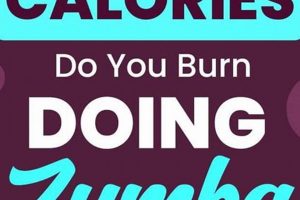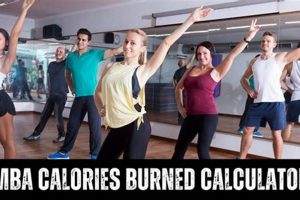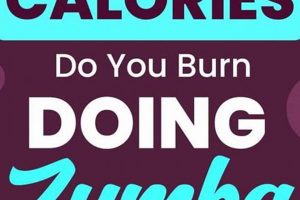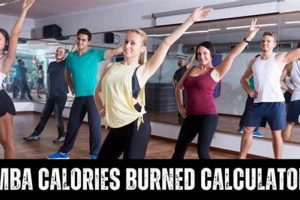The estimation of energy expenditure during a Zumba class lasting sixty minutes is a common query. The quantity of calories expended is not a fixed number but rather a variable dependent on several factors including an individual’s weight, fitness level, and the intensity at which they participate in the activity.
Understanding the variables affecting caloric expenditure can be beneficial for individuals managing their weight or aiming to improve their cardiovascular health. Zumba, a dance-fitness program, has gained popularity for its accessibility and potential to provide a fun and engaging workout. Its rise in popularity underscores a demand for enjoyable exercise methods capable of delivering measurable results.
The following sections will delve into the specific factors that influence energy consumption during a Zumba workout and provide a range of estimated caloric expenditure values for a one-hour session.
Maximizing Caloric Expenditure During a Zumba Class
To optimize the energy expenditure during a Zumba session, consider the following strategies.
Tip 1: Increase Intensity. Elevating the intensity of movements throughout the class can significantly affect the total calories burned. Focus on executing dance steps with greater force and range of motion.
Tip 2: Maintain Consistent Movement. Minimize breaks during the class. Reducing the time spent at rest allows for a sustained elevated heart rate, promoting higher caloric expenditure.
Tip 3: Engage Core Muscles. Actively engaging core muscles during dance routines not only enhances stability but also contributes to increased energy consumption.
Tip 4: Increase Class Frequency. Participating in Zumba classes more frequently throughout the week can result in a higher cumulative caloric deficit over time.
Tip 5: Focus on Full Body Movements. Prioritize utilizing full body movements instead of limiting motions to only arms or legs. Incorporating larger muscle groups will increase the body’s overall energy demand.
Tip 6: Hydrate Adequately. Maintaining proper hydration can optimize metabolic function, contributing to better performance and potentially increasing the number of calories utilized.
Tip 7: Be Mindful of Posture. Maintain good posture throughout the class. Proper alignment promotes efficient muscle engagement and reduces the risk of injury, enabling sustained participation and maximizing energy expenditure.
By implementing these strategies, individuals can potentially increase the number of calories burned during a typical Zumba class, leading to improved fitness outcomes.
These tips can serve as a practical guide for maximizing the benefits derived from Zumba workouts and achieving individual fitness goals.
1. Weight's Influence
An individual’s body weight is a primary determinant of energy expenditure during physical activity, including a Zumba class. A heavier individual requires more energy to perform the same movements as a lighter person. This increased energy demand translates directly into a higher caloric expenditure within the same time frame. For instance, an individual weighing 200 pounds will expend more calories during a one-hour Zumba class compared to someone weighing 150 pounds, assuming all other factors like intensity and fitness level remain constant. This is because the body must work harder to move a larger mass against gravity and inertia.
The impact of weight extends beyond simple physics. Individuals with higher body weights often have a greater proportion of lean muscle mass to support that weight. Muscle tissue is metabolically more active than fat tissue, contributing to a higher resting metabolic rate and, consequently, a greater caloric burn during exercise. Moreover, the effort required to execute dance steps, jumps, and turns during Zumba increases proportionally with weight. This necessitates the body to recruit more muscle fibers and expend more energy to maintain balance and coordination.
In summary, weight acts as a significant multiplier in the equation of caloric expenditure during Zumba. While intensity, fitness level, and other factors play a role, weight establishes a baseline energy requirement. Recognizing this influence is crucial for setting realistic fitness goals and tailoring exercise routines to individual needs. Understanding the correlation between weight and caloric burn allows for a more informed approach to weight management and optimizing the benefits derived from a Zumba workout.
2. Intensity Matters
The intensity of physical exertion is directly proportional to the caloric expenditure during a given activity. In the context of a one-hour Zumba class, a higher average intensity translates to a significantly larger number of calories utilized compared to a lower intensity session. This relationship stems from the body’s increased demand for energy to fuel more rapid and forceful muscle contractions, elevated heart rate, and accelerated respiration. The greater the physical demands imposed by the exercise, the more calories are consumed from the body’s energy reserves. For example, a class emphasizing high-impact movements, such as jumps and leaps, with minimal rest periods, will result in a greater energy expenditure than a class focused on slower, low-impact choreography with frequent pauses.
The practical significance of understanding this connection lies in the ability to modulate caloric expenditure based on individual fitness goals and limitations. Participants seeking to maximize weight loss or improve cardiovascular endurance can intentionally increase their effort level by amplifying their range of motion, maintaining a faster pace, and minimizing recovery time. Conversely, individuals new to Zumba or those with physical limitations can modify the intensity by reducing their range of motion, taking breaks as needed, and focusing on mastering the basic steps before progressing to more challenging variations. The ability to self-regulate intensity empowers participants to tailor their experience to their specific needs and abilities while still deriving the benefits of the workout.
In conclusion, the intensity of a Zumba class is a critical factor influencing energy consumption. Acknowledging and manipulating this variable allows for a personalized approach to fitness, enabling individuals to optimize their workouts for maximum caloric expenditure or to safely engage in physical activity while gradually building their fitness levels. The correlation between intensity and caloric burn underscores the importance of consistent effort and mindful participation in achieving desired fitness outcomes.
3. Metabolic Rate
Metabolic rate, the energy expenditure rate of a living organism, exerts a substantial influence on the number of calories utilized during a Zumba class. An elevated metabolic rate directly corresponds to a greater caloric expenditure for the same activity level. Individuals with a higher basal metabolic rate (BMR), the energy required to sustain vital functions at rest, inherently burn more calories at any activity level, including Zumba. Factors affecting BMR include age, gender, body composition (muscle mass), and genetics. For instance, a younger individual with more muscle mass typically exhibits a higher BMR compared to an older individual with less muscle mass, resulting in a greater caloric burn during a sixty-minute Zumba session, assuming all other variables are equal.
The connection between metabolic rate and exercise extends beyond BMR. Physical activity, such as a Zumba class, stimulates the body to elevate its metabolic rate during and after the workout. This phenomenon, known as the “afterburn effect” or Excess Post-exercise Oxygen Consumption (EPOC), signifies that the body continues to burn calories at a higher rate even after the exercise has ceased. The magnitude of EPOC is influenced by the intensity and duration of the workout, with more intense and prolonged activities eliciting a more pronounced and sustained afterburn effect. Therefore, a Zumba class incorporating high-intensity intervals and varied dance styles can contribute to a significantly elevated metabolic rate, maximizing the overall caloric expenditure.
Understanding the relationship between metabolic rate and caloric expenditure during Zumba holds practical significance for individuals seeking to manage their weight or improve their fitness levels. By incorporating strategies to increase their metabolic rate, such as building muscle mass through strength training and engaging in regular cardiovascular exercise, individuals can augment their caloric burn during Zumba classes and enhance their overall metabolic health. Recognizing the interplay between metabolic rate and physical activity empowers individuals to make informed choices regarding their exercise routines and lifestyle habits, ultimately optimizing their fitness outcomes.
4. Fitness Level
Fitness level is a critical determinant in gauging the energy expenditure during a Zumba class. Pre-existing physical conditioning impacts the efficiency with which the body performs dance movements, influencing the overall caloric output during a one-hour session.
- Cardiovascular Efficiency
An individual with higher cardiovascular fitness exhibits a lower heart rate and oxygen consumption at a given intensity compared to a less fit individual. This enhanced efficiency means their body requires less energy to perform the same Zumba routine, resulting in a lower caloric expenditure. A trained cardiovascular system allows for more efficient delivery of oxygen to working muscles, reducing the reliance on anaerobic metabolism and its associated caloric demands.
- Muscular Endurance
Increased muscular endurance allows for sustained participation in the Zumba class without premature fatigue. Participants with higher muscular endurance can maintain proper form and intensity throughout the hour, maximizing the work performed and thus the calories utilized. Conversely, a less fit individual may experience muscle fatigue, leading to decreased intensity and reduced caloric burn, or even the need to take frequent breaks.
- Movement Economy
Greater familiarity with dance movements and improved coordination lead to enhanced movement economy. A fitter individual will execute the Zumba routines with less wasted motion and more efficient muscle recruitment. This optimized movement pattern requires less energy expenditure compared to a novice who may struggle with coordination and utilize more energy to perform the same steps. Enhanced movement economy directly translates to a lower caloric requirement for the same level of activity.
- Body Composition
Fitness level often correlates with body composition, specifically the ratio of muscle mass to fat mass. Individuals with a higher proportion of muscle mass typically exhibit a higher resting metabolic rate (RMR), contributing to a higher caloric burn even during rest. While this directly affects baseline calorie expenditure, it also has an indirect impact during Zumba as muscle is more metabolically active than fat, leading to slightly increased calorie consumption during exercise for those with higher muscle mass.
These facets highlight the intricate relationship between fitness level and caloric expenditure during a Zumba class. Understanding these nuances allows individuals to tailor their exercise routines and expectations, promoting realistic fitness goals and maximizing the benefits derived from participation.
5. Class Structure
The configuration of a Zumba class significantly influences the total caloric expenditure. Varying elements within the structure, such as warm-up duration, intensity intervals, and cool-down phases, collectively determine the energy demand placed upon the body during a one-hour session. Therefore, analyzing the class structure is crucial to understand the potential caloric output.
- Warm-up Duration and Intensity
The warm-up phase prepares the body for higher intensity activity. A longer, more vigorous warm-up elevates heart rate and muscle temperature, initiating metabolic processes. A shorter or less intense warm-up might result in a slower transition to the active phase, potentially impacting the initial rate of caloric expenditure. This initial preparation can affect the body’s capacity to fully engage during peak intensity segments.
- High-Intensity Interval Integration
Zumba classes often incorporate intervals of high-intensity dance routines followed by periods of lower-intensity activity or recovery. The frequency, duration, and relative intensity of these intervals play a key role in the average caloric expenditure. Classes with more frequent and extended high-intensity periods typically result in a greater overall caloric burn compared to classes with fewer or shorter high-intensity intervals. The magnitude of the intensity swings dictates the metabolic demand.
- Choreography Complexity and Variety
The complexity and variety of dance routines influence the engagement of different muscle groups and the overall physical exertion. More complex choreography requires greater coordination and cognitive effort, potentially increasing energy expenditure. Classes that incorporate a diverse range of dance styles and movements may engage a wider array of muscle groups, leading to a more comprehensive caloric burn compared to classes with repetitive or simple choreography. Coordination plays a significant role in energy usage.
- Cool-down Duration and Type
The cool-down phase facilitates a gradual return to a resting state. A longer cool-down incorporating stretching and low-intensity movements can extend the elevated metabolic rate for a short period, contributing to the overall caloric expenditure. A shorter or less structured cool-down may result in a quicker return to baseline metabolic activity, potentially reducing the total calories expended. The method of deceleration impacts ongoing energy consumption.
In summary, the strategic integration of various structural elements within a Zumba class determines the overall energy demands and thus impacts the ultimate caloric expenditure. Class formats focusing on high-intensity intervals, complex choreography, and a substantial warm-up and cool-down may lead to a greater caloric burn. The architecture of the class is a significant modulator of potential energy utilization.
6. Muscle Mass
The quantity of muscle mass an individual possesses significantly impacts the number of calories utilized during physical activity, including a Zumba class. Muscle tissue is metabolically more active than adipose tissue, requiring more energy to maintain itself and to facilitate movement. Therefore, individuals with a higher proportion of muscle mass tend to expend more calories during physical exertion compared to those with lower muscle mass, assuming all other variables are constant.
- Resting Metabolic Rate (RMR) Influence
Muscle tissue contributes significantly to RMR, the number of calories the body burns at rest to maintain basic physiological functions. A higher muscle mass elevates RMR, leading to a greater baseline caloric expenditure. Consequently, even during the less intense portions of a Zumba class, such as the warm-up or cool-down, individuals with more muscle mass will burn more calories. This effect amplifies the overall caloric expenditure throughout the duration of the session. For example, an individual with a well-developed musculature may burn 10-15% more calories at rest, and this difference is carried through exercise.
- Energy Demand During Activity
During Zumba, muscles are the primary drivers of movement. A greater muscle mass necessitates a greater energy supply to power the contractions required for dance steps and routines. This heightened energy demand translates directly into an increased caloric burn. Individuals with well-developed muscles can often perform Zumba routines with greater intensity and for longer durations, further amplifying caloric expenditure. Consider a weightlifter versus a sedentary person in a Zumba class; the weightlifter’s musculature enables more powerful and sustained movements.
- Post-Exercise Oxygen Consumption (EPOC)
The “afterburn effect,” or EPOC, refers to the elevated oxygen consumption that occurs after exercise as the body recovers and restores its energy stores. Muscle tissue plays a critical role in this process. Individuals with greater muscle mass exhibit a more pronounced EPOC following a Zumba class, leading to a prolonged period of elevated caloric expenditure. This post-exercise caloric burn contributes significantly to the overall energy balance and can aid in weight management. The presence of more muscle tissue allows for increased processing and replenishment post-exercise.
- Glycogen Storage and Utilization
Muscle tissue is the primary storage site for glycogen, the body’s readily available source of energy. Individuals with more muscle mass possess a greater capacity to store glycogen. During a Zumba class, the body utilizes glycogen to fuel muscle contractions. Individuals with greater muscle mass can store and utilize glycogen more efficiently, potentially leading to a higher rate of caloric burn. This more efficient system allows for faster energy production, therefore higher power movements during Zumba.
In conclusion, the amount of muscle tissue directly influences the number of calories utilized during a Zumba class. By elevating RMR, increasing energy demand during activity, enhancing EPOC, and optimizing glycogen storage and utilization, muscle mass acts as a key factor in maximizing caloric expenditure. Individuals seeking to optimize their Zumba workouts for weight management or fitness improvement should prioritize strategies to increase and maintain muscle mass.
7. Effort Applied
The level of exertion exerted during a Zumba class is a primary determinant of the energy expended, directly influencing caloric utilization within a sixty-minute interval. The commitment and intensity with which movements are executed define the metabolic demands and, consequently, the overall caloric output.
- Range of Motion
The amplitude and extent of movements performed during Zumba routines significantly impact caloric expenditure. Utilizing a full range of motion in dance steps, arm movements, and torso twists requires more muscle activation and energy compared to performing partial or restricted movements. For example, a deep squat during a salsa step utilizes more muscle fibers and consumes more calories than a shallow bend. The degree of motion directly corresponds to the mechanical work performed and the energy required. Participants who actively strive for maximum range of motion in each movement will experience a higher caloric burn.
- Movement Speed and Pace
The velocity at which dance steps are executed and the overall pace of the Zumba class contribute to the caloric demand. Faster movements require more rapid muscle contractions and increased cardiovascular effort, leading to a greater energy expenditure. A participant who consistently maintains the tempo and rhythm of the class, without lagging or taking extended breaks, will expend more calories than someone who moves at a slower pace or frequently pauses. Sustained momentum is a key driver of metabolic activity.
- Active Muscle Engagement
The degree to which muscles are consciously engaged during the Zumba class influences the caloric burn. Actively contracting core muscles during dance routines, engaging glutes during squats, and utilizing arm muscles during upper body movements increases energy expenditure. Participants who focus on isolating and engaging specific muscle groups throughout the workout will experience a greater caloric output compared to those who passively perform the steps. The conscious activation of muscle tissues elevates their metabolic demand.
- Adherence to Form and Technique
Maintaining proper form and technique during Zumba routines optimizes muscle activation and prevents wasted energy. Correct posture, alignment, and coordination allow for more efficient execution of movements, minimizing strain on joints and maximizing caloric expenditure. Participants who prioritize proper form and technique will experience a more effective and energy-efficient workout compared to those who compromise form. Skilled technique leads to greater efficiency and potentially reduced risk of injury.
The cumulative effect of these effort-related elements directly influences the quantity of calories burned during a Zumba class. Consistent application of maximum range of motion, maintained pace, active muscle engagement, and adherence to proper form and technique are fundamental to optimizing energy expenditure during the activity. The dedication to maximizing effort is paramount to achieving measurable fitness results and caloric utilization.
Frequently Asked Questions
The following addresses common inquiries regarding energy consumption during a typical Zumba session lasting one hour.
Question 1: Is there a fixed caloric expenditure for all individuals participating in Zumba for one hour?
No, caloric expenditure is not uniform. It varies based on weight, intensity, fitness level, and metabolic rate. A range of values is possible.
Question 2: Does a higher body weight automatically guarantee a significantly greater caloric burn during Zumba?
While weight is a factor, intensity and fitness level play substantial roles. A lighter, highly fit individual may expend a similar number of calories to a heavier, less fit individual performing the same Zumba routine.
Question 3: Is it possible to accurately calculate caloric expenditure during Zumba without specialized equipment?
Accurate measurement requires sophisticated equipment. Estimations based on average values may be obtained, but these lack individual precision.
Question 4: Does the specific type of Zumba influence the number of calories burned?
Variations exist. Zumba Toning, for instance, may incorporate resistance elements, potentially increasing caloric expenditure compared to standard Zumba.
Question 5: Can consistent Zumba participation alter resting metabolic rate and, consequently, caloric expenditure during subsequent workouts?
Potentially. Regular exercise, including Zumba, may contribute to increased muscle mass, thereby elevating resting metabolic rate and influencing future caloric expenditure.
Question 6: Does hydration status affect caloric expenditure during Zumba?
Dehydration can impede metabolic processes, potentially reducing caloric expenditure. Maintaining adequate hydration is important for optimal performance and energy utilization.
These responses clarify factors influencing caloric expenditure during Zumba, emphasizing individual variability and the complex interplay of contributing elements.
The following section will explore strategies for monitoring progress and assessing the effectiveness of Zumba as a fitness regimen.
“How Many Calories Burned Zumba 1 Hour”
The examination of “how many calories burned zumba 1 hour” reveals a complex interplay of factors determining energy expenditure. Individual characteristics, class structure, and applied effort all contribute to the overall caloric outcome. No single number universally applies, emphasizing the need for personalized consideration.
Understanding these variables empowers individuals to optimize their Zumba workouts and make informed fitness decisions. While estimations provide a general guideline, consistent monitoring of progress and attention to modifiable factors, such as intensity and effort, remain crucial for achieving desired results. The value lies not in a precise caloric count but in the sustained commitment to physical activity and overall well-being.







